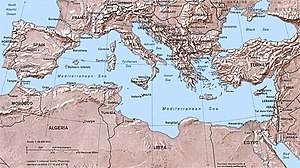|
Exercise Grand Slam
Exercise Grand Slam was an early major naval exercise of the newly formed North Atlantic Treaty Organization (NATO). This 1952[1][2] combined naval exercise took place in the Mediterranean Sea, and it included a naval force that was described as being "the largest armada to be assembled in that area since the end of World War II."[3] Exercise Grand Slam was an early test for NATO's Allied Forces Southern Europe. With Exercise Longstep, this exercise served as the prototype for future NATO maritime exercises in the Mediterranean Sea during the Cold War.[3] BackgroundIn January 1950, the North Atlantic Council approved NATO's military strategy of deterring Soviet aggression.[4] NATO military planning took on a renewed urgency following the outbreak of the Korean War in mid-1950, prompting NATO to establish a "force under a centralised command, adequate to deter aggression and to ensure the defence of Western Europe". Allied Command Europe was established under General of the Army Dwight D. Eisenhower, U.S. Army, on 2 April 1951.[5][6] The Western Union Defence Organization had previously carried out Exercise Verity, a 1949 multilateral exercise involving naval air strikes and submarine attacks. Command structureThe overall exercise commander for Grand Slam was Admiral Robert B. Carney USN, NATO's Commander-in-Chief Allied Forces Southern Europe (CINCSOUTH).[3] AFSOUTH component commanders during Grand Slam were:[7][8]
Operational history The exercise took place in the Mediterranean Sea between 25 February and 16 March 1952.[9] Over 200 warships from the U.S. Sixth Fleet, British Mediterranean Fleet, French Mediterranean forces, and the Italian Navy deployed from bases in the British Isles, Southern France, Italy, Gibraltar, Malta, and North Africa for Exercise Grand Slam.[3] The main force was centered around the aircraft carriers USS Midway, USS Tarawa, HMS Theseus, and La Fayette.[3] Also, the U.S. Marine Corps Battalion Landing Team 3/8 (Reinforced) was the Landing Force (Task Force 62) for the U.S. Sixth Fleet following its deployment from Morehead City, North Carolina, on 8 January 1952, returning to Camp Lejeune on 20 May.[10] Marine Detachment, Headquarters Support Activities of CINCSOUTH was activated at Naples, Italy, on 8 March 1952 under the command of Captain Raymond B. Spicer, USMC.[10] Land-based aircraft from all four nations, as well as American, British, and French submarines, rounded out the allied forces involved in this exercise.[1][3] Allied warships escorted three convoys of supply ships which were subjected to repeated simulated air and submarine attacks.[3] One convoy that departed Malta experienced air attacks every four hours and submarine attacks every five hours during its entire six days at sea. Opposition forces against this particular convoy included the French naval task force, land-based strike aircraft, and carrier-based aircraft from the Midway.[3] All three convoys arrived at their respective destinations although with numerous ships declared damaged or sunk by the simulated enemy attacks.[3] Anti-submarine warfare (ASW) operations were also executed by the allied navies during Operation Grand Slam. However, a French submarine successfully penetrated the destroyer screen protecting the American-French carrier task force and successfully sank a target within that formation. That French submarine was subsequently declared to be heavily crippled by ASW forces.[3] Finally, a surface force consisting of eight cruisers and ten destroyers carried out a shore bombardment off the Sardinian coast.[3] Carrier aviation unitsCarrier Air Group Six embarked on USS Midway (CVB-41):
Carrier Air Group Eight embarked on USS Tarawa (CV-40):
14th Carrier Air Group embarked on HMS Theseus (R64):[11] ConclusionThe overall exercise commander, Admiral Carney summarized the accomplishments of Exercise Grand Slam by stating: "We have demonstrated that the senior commanders of all four powers can successfully take charge of a mixed task force and handle it effectively as a working unit."[3] Exercise Grand Slam did receive comparatively little contemporary media coverage.[2] The U.S. Navy's All Hands magazine noted that Grand Slam was "an exercise which will probably prove typical of future NATO naval exercises."[3] See alsoNotes
External links
|
||||||||||||||||||||||||||||
